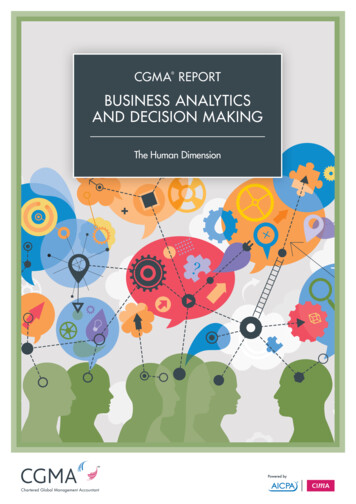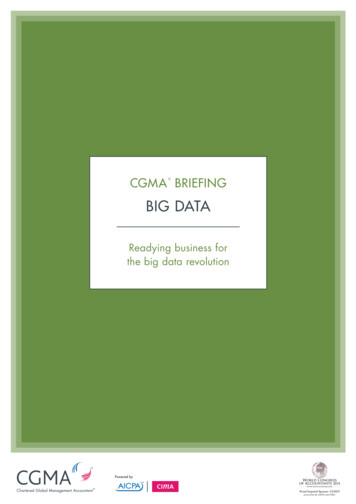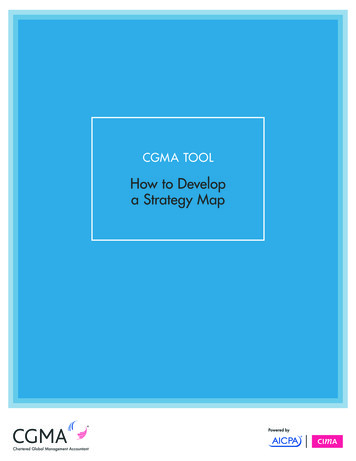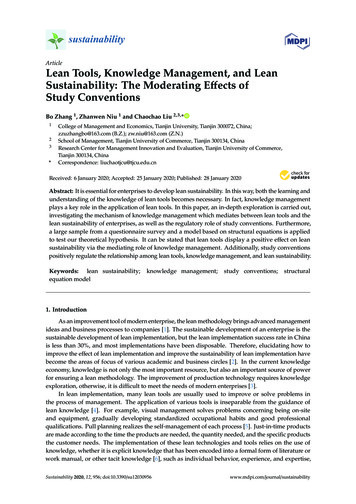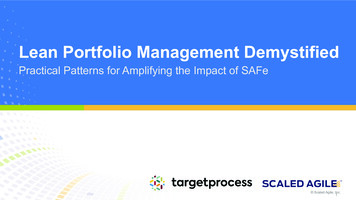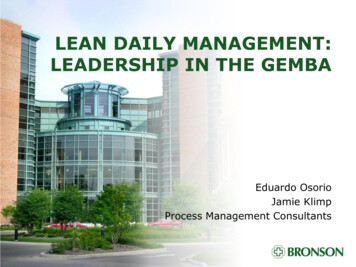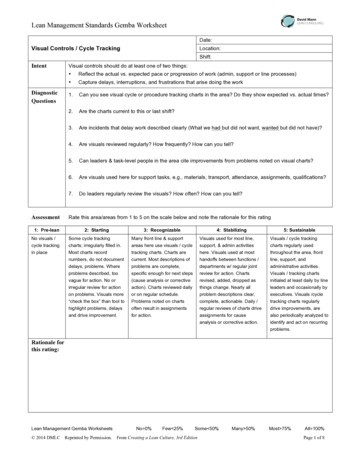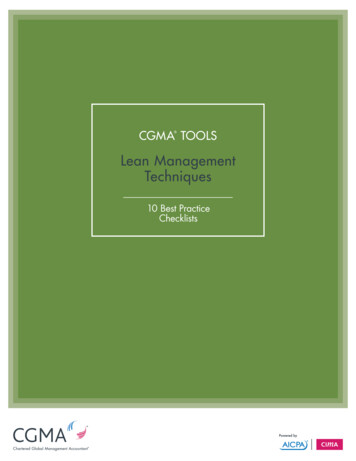
Transcription
CGMA TOOLS Lean ManagementTechniques10 Best PracticeChecklists
Two of the world’s most prestigious accounting bodies, AICPA andCIMA, have formed a joint venture to establish the Chartered GlobalManagement Accountant (CGMA ) designation to elevate andbuild recognition of the profession of management accounting. Thisinternational designation recognises the most talented and committedmanagement accountants with the discipline and skill to drive strongbusiness performance. CGMA designation holders are either CPAs withqualifying management accounting experience or associate or fellowmembers of the Chartered Institute of Management Accountants.
CONTENTSIntroduction2What is the Lean Concept?2Benefits of the Lean Philosophy2Lean Manufacturing Overview3Lean Management — Best Practices Checklist5Accounts Payable6Billing8Budgeting9Cash cial Statements14General Ledger15Payroll16Further Readings17
INTRODUCTIONIn today’s competitive environment, we are challenged to do more with fewer resources. One of thebest ways to increase effectiveness and efficiency is to adopt Lean Management techniques. All typesof business — manufacturing, service, for-profit, not-for-profit, education and health — can benefitfrom the Lean approach. The manufacturing industry has been implementing the Lean approach formany years. However there are still organisations that have a long way to go to become leaner. Thistool provides ways to help organisations identify and reduce waste in their processes and proceduresand ultimately enhance the value of the organisation.WHAT IS THE LEAN CONCEPT?One of the more interesting trends to affect profitability aswell as the way in which companies address overall efficiencyis the concept of “Lean.”1. Only do what the customer values, and2. Relentless identification and elimination of waste.Lean is based on two main philosophies:BENEFITS OF THE LEAN PHILOSOPHYWhen Lean is successfully implemented through effectiveplanning and implementation the following will occur: Enhance communications Reduce costs Reduce lead time Improve on-time deliveries Reduce work in process Increase sales Improve quality Improve space utilisation Improve flexibility Reduce transactions Simplify schedulingLEAN MANAGEMENT TECHNIQUES — 10 BEST PRACTICE CHECKLISTS2
LEAN MANUFACTURING OVERVIEWWhat is Lean Manufacturing? Lean manufacturing isa team-based systematic approach to identifying andeliminating wasteful or non-value-adding activities withinthe manufacturing environment. It is a whole way ofthinking, and should be considered much more than aseries of programs or techniques. It must become a wholesystem approach in order to create a new operatingphilosophy, which focuses on eliminating all non-valueadding activities from order entry to receipt of payment.Within Lean there are major areas of emphasis whichneed to be understood:The 5S system has been labeled as a commonsense approach to improvement within a facility ormanufacturing plant that focuses on organisation,cleanliness and standardisation to improve profitability,efficiency, service, and safety. The basis of a 5 System isnot very complicated. What do the 5Ss stand for? S ort: Clearing the work area — Any work area shouldonly have the items needed to perform the work in thearea. All other items should be cleared (sorted out) fromthe work area. Set in Order: Designating locations — Everything in thework area should have a place and everything shouldbe in its place. Shine: Cleanliness and workplace appearance — Notonly should the work area be clear, it should alsobe clean. Cleanliness involves housekeeping efforts,improving the appearance of the work area, and evenmore importantly, preventive housekeeping — keepingthe work area from getting dirty, rather than justcleaning it up after it becomes dirty. Standardise: Everyone doing things the same way —Everyone in the work area and in the organisationmust be involved in the 5S effort, creating best practicesand getting everyone to “copy” those best practicesthe same way, everywhere, and every time. Work arealayouts and storage techniques should be standardisedwherever possible. Sustain: Ingraining the 5Ss into the culture — It is toughto keep a 5S effort, or any improvement effort for thatmatter, going. The 5Ss involve a culture change. Andto achieve a culture change, it has to be ingrained intothe organisation — by everyone at all levels.Visual Controls are documented methods andprocedures. Typically, they include easy-to-follow visualcues for actions to be taken. A common example is thestandardised work chart. By using visual controls, staffand managers are more able to see the current status ofthe job site and determine if any abnormalities exist. Thisalso allows for all workers to see if items are not in thecorrect place and correct the situation through inspectionby visual control. Standardised work charts typically arean extremely effective visual management tool that resultsin improvements in safety, quality and efficiency whileimproving cost effectiveness.Value Stream provides an integrated description ofhow a product passes through all stages of production.This process establishes the value of each section of thevalue stream. Typically, the value stream will look like aflowchart that outlines all steps in the process or product’slife. This is equally applied to service processes (even backoffice) as well as manufacturing.Pull is a method for moving inventory througha production process. Traditional manufacturingincorporated batch processing. These batches wereplanned based on a specific lot sizes. In the pull process,nothing moves forward until it is “called” for by thecustomer or the next processing step. In a pull system,an item that is sold immediately generates an order toproduce another. This is often compared to a grocery storewhere items are replaced on the shelves as they are used.In this fashion only the most current material is beingprocessed. Pull production results in eliminating wastefulinventory buildups and employs elements of just-in-timedelivery, one-piece flow, etc.Mistake Proofing uses devices to prevent defects frompassing on to the next process. This approach is anLEAN MANAGEMENT TECHNIQUES — 10 BEST PRACTICE CHECKLISTS3
statistical tools. It uses a structured systems approach toproblem-solving and strongly links initial improvementgoal targets to bottom-line results.improvement over traditional quality approaches, whichevaluate for defects at the end of the assembly line. Mistakeproofing requires that process quality checks are builtinto the operations and the equipment has the appropriatesensors to detect errors and stop the process.Quick Changeover is a concept used to eliminate theneed for any adjustment by inventing ways of doing itonce and forever with a permanent solution. One of thebiggest wastes of resources is the time when a machine isnot in production. This time is created when productionlines need to be adapted and adjusted to run a differenttype of product. The ability to rapidly change fromone product to another is often a key success for manycompanies. As customer lead times are continually beingshortened and product mixes become more complex, theability to rapidly change from one product to another isa competitive advantage. Fortunately there are powerful,quick-change techniques that can be applied to any type ofoperation: from metal to wood, from food to plastic, etc.Six Sigma is a highly structured process to improvequality using specific methods and analytic tools. SixSigma is a robust continuous improvement strategy andprocess that includes cultural methodologies such as TotalQuality Management (TQM), process control strategiessuch as Statistical Process Control (SPC) and otherTheory of Constraints is based on the fact that, like achain with its weakest link, in any complex system at anygiven point in time, there is most often only one aspect ofthat system that is limiting its ability to achieve more ofits goal. For that system to attain significant improvement,that constraint must be identified and the whole systemmust be managed with it in mind.Kaizen Blitz is an intensive and focused approachto Process Improvement. Kaizen means “continuousimprovement” and Blitz means “lightning fast.” Thiscontinuous improvement methodology will incorporateall elements of Lean Manufacturing Tools such as the 5Ss,Workplace Organisation and Standardisation, Cells, Pull,Set-up Reduction, and Line Balancing. To be successfuleach team will need to be empowered, they will need tohave freedom to make changes, and they will need tobe good analysers, creative, and problem solvers. Thiscombination will allow teams to make rapid improvementsto a specific product or process.LEAN MANAGEMENT TECHNIQUES — 10 BEST PRACTICE CHECKLISTS4
LEAN MANAGEMENT — BEST PRACTICE CHECKLISTSIt usually is recommended that an organisation goes through an in-depth processanalysis to implement a Lean methodology. Those who would like to immediately findareas to improve can jump straight to best practice checklists. The concept behind thisprocess is that an organisation that can adopt best practices and immediately switchtheir process will pick up significant Lean benefits. Examples of short best-practicechecklists are provided below. Note that those recommendations could vary dependingon the nature and landscape of the organisation. Accounts payable Costing Billing Inventory Budgeting Financial statements Cash management General ledger Collections PayrollLEAN MANAGEMENT TECHNIQUES — 10 BEST PRACTICE CHECKLISTS5
Accounts Payable Best PracticesYESNON/ACOMMENTSAudit expense reportAutomate expense reportingAutomate payments for repetitive invoicingAutomate three-way matchingAutomate value-added tax analysisCentralise the accounts payable functionCreate direct purchase interfaces to suppliersCreate online purchasing catalogueDigitise accounts payable documentsDirectly enter receipts into computerEliminate manual checksHave suppliers include their supplier numbers on invoicesInternet-based monitoring of credit card purchasesIssue standard account code listLink corporate travel policies to an automated expensereporting systemLink supplier requests to the accounts payable databasePay based on receiving approval onlyReceive billings through electronic data interchange (EDI)Reduce required approvalsRequest that suppliers enter all invoices through a websiteShift incoming billings to an EDI data-entry supplierLEAN MANAGEMENT TECHNIQUES — 10 BEST PRACTICE CHECKLISTS6
Accounts Payable Best PracticesYESNON/ACOMMENTSShrink the supplier baseSubstitute petty cash for checksSubstitute wire transfers for checksTransmit expense reports by emailUse blanket purchase ordersUse procurement cardsUse signature stampsLEAN MANAGEMENT TECHNIQUES — 10 BEST PRACTICE CHECKLISTS7
Billing Best PracticesYESNON/ACOMMENTSAdd carrier route codes to billing addressesAutomatically check errors during invoice data entryComputerise the shipping logEnsure delivery person creates the invoiceEnsure delivery person delivers the invoiceProcess early billing of recurring invoicesIssue electronic invoices through the InternetIssue single, summarised invoices each periodOffer customers secure Internet payment optionsPrint separate invoices for each line itemReduce number of parts in multi-part invoicesReplace inter-company invoicing with operating transactionsTrack exceptions between the shipping log and invoiceregisterTransmit transmissions via electronic data interchange (EDI)Use automated bank account deductionsLEAN MANAGEMENT TECHNIQUES — 10 BEST PRACTICE CHECKLISTS8
Budgeting Best PracticesYESNON/ACOMMENTSAutomatically link the budget to purchase ordersBudget by groups of staff positionsClearly define all assumptionsClearly define all capacity levelsCreate a summarised budget model for use by uppermanagementEstablish project ranking criteriaEstablish the upper limit of available fundingIdentify step-costing change pointsInclude a working capital analysisIssue a budget procedure and timetableLink to performance measurements and rewardsReduce the number of accountsSimplify the budget modelStore budget information in a central databaseUse activity-based budgetingUse flex budgeting (use cost drivers)Use online budget updatingLEAN MANAGEMENT TECHNIQUES — 10 BEST PRACTICE CHECKLISTS9
Cash Management Best PracticesYESNON/ACOMMENTSImplement area-concentration bankingConsolidate bank accountsApply controlled disbursementsSet up electronic funds transferUse lockbox collectionsOnline access to bank account informationCreate positive pay systemProliferate petty-cash boxesUtilise an investment policyZero-balance accountsLEAN MANAGEMENT TECHNIQUES — 10 BEST PRACTICE CHECKLISTS10
Collections Best PracticesYESNON/ACOMMENTSAccess to customer assets databaseAccess to customer orders databaseAutomate bankruptcy notificationAutomate notification of overdue invoicesIssue automatic dunning lettersUse collection call databaseUtilise collection call stratificationSet customer-order exception trackingGrant percentage discounts for early paymentImmediate review of unapplied cashLink to comprehensive collections software packageUse lockbox collectionsSet pre-approved customer creditSimplify pricing structureStandardised credit level determination systemWrite off small balances with no approvalLEAN MANAGEMENT TECHNIQUES — 10 BEST PRACTICE CHECKLISTS11
Costing Best PracticesYESNON/ACOMMENTSAudit bills of materialAudit labour routingsEliminate high-leverage overhead allocation basesEliminate labour variance reportingFollow a schedule of inventory obsolescence reviewsImplement activity-based costingImplement target costingLimit access to unit of measure changesReview cost trendsReview material scrap levelsRevise traditional cost accounting reportsLEAN MANAGEMENT TECHNIQUES — 10 BEST
all elements of Lean Manufacturing Tools such as the 5Ss, Workplace Organisation and Standardisation, Cells, Pull, Set-up Reduction, and Line Balancing. To be successful each team will need to be empowered, they will need to have freedom to make changes, and they will need to be good analysers, creative, and problem solvers. This combination will allow teams to make rapid improvements to a .File Size: 278KBPage Count: 21
